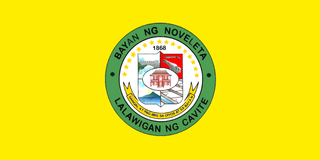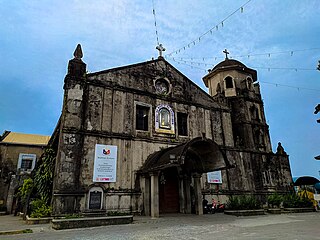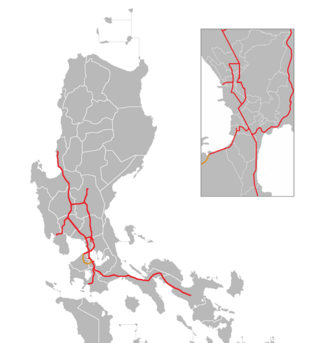
Laguna, officially the Province of Laguna, is a province in the Philippines located in the Calabarzon region in Luzon. Its capital is Santa Cruz while its largest city is the City of Calamba and the province is situated southeast of Metro Manila, south of the province of Rizal, west of Quezon, north of Batangas and east of Cavite. Laguna hugs the southern shores of Laguna de Bay, the largest lake in the country. As of the 2020 census, the province's total population is 3,382,193. It is the seventh richest province in the country in 2016.

Calabarzon, sometimes referred to as Southern Tagalog and designated as Region IV‑A, is an administrative region in the Philippines. The region comprises five provinces: Batangas, Cavite, Laguna, Quezon, and Rizal; and one highly urbanized city, Lucena. It is the most populous region in the Philippines according to the Philippine Statistics Authority (PSA), having over 16.1 million inhabitants in 2020, and is also the country's second most densely populated after the National Capital Region. It is situated southeast of Metro Manila, and is bordered by Manila Bay and South China Sea to the west, Lamon Bay and the Bicol Region to the east, Tayabas Bay and the Sibuyan Sea to the south, and Central Luzon to the north. It is home to places like Mount Makiling near Los Baños, Laguna, and Taal Volcano in Batangas.

Southern Tagalog, designated as Region IV, was an administrative region in the Philippines that comprised the current regions of Calabarzon and Mimaropa, the province of Aurora in Central Luzon, and most of the National Capital Region. It was the largest region in the Philippines in terms of both land area and population. After its partition on May 17, 2002, Southern Tagalog continues to exist as a cultural-geographical region.

San Pablo, officially the City of San Pablo, is a 1st class component city in the province of Laguna, Philippines. According to the 2020 census, it has a population of 285,348 people.

Tagaytay, officially the City of Tagaytay, is a 2nd class component city in the province of Cavite, Philippines. According to the 2020 census, it has a population of 85,330 people.

San Pedro, officially the City of San Pedro, is a 3rd class component city in the province of Laguna, Philippines. According to the 2020 census, it has a population of 326,001 people.

Calamba, officially the City of Calamba, is a 1st class component city in the province of Laguna, Philippines. According to the 2020 census, it has a population of 539,671 people.

Santa Rosa, officially the City of Santa Rosa, is a 1st class component city in the province of Laguna, Philippines. According to the 2020 census, its population was 414,812 people.

The South Luzon Expressway (SLEX), signed as E2 of the Philippine expressway network and R-3 of the Metro Manila arterial road network, is a controlled-access highway that connects Metro Manila to the provinces in the Calabarzon, Mimaropa and Bicol Region on the island of Luzon in the Philippines. The expressway has a length of 49.56 km, traveling from its northern terminus at the Magallanes Interchange in Makati to its southern terminus at Santo Tomas, Batangas, connecting it to the Southern Tagalog Arterial Road. A portion of the expressway from the Magallanes Interchange to the Calamba Exit is part of Asian Highway 26 of the Asian highway network. It will be the longest expressway in the Philippines starting with the completion of Toll Road 4, surpassing the Subic–Clark–Tarlac Expressway (SCTEX).

Biñan, officially the City of Biñan, is a 1st class component city in the province of Laguna, Philippines. According to the 2020 census, it has a population of 407,437 people.

Cabuyao, officially the City of Cabuyao, is a 1st class component city in the province of Laguna, Philippines. According to the 2020 census, it has a population of 355,330 people.

General Trias, officially the City of General Trias, formerly known as San Francisco de Malabon is a 1st class component city in the province of Cavite, Philippines. According to the 2020 census, it has a population of 450,583 people.

Noveleta, officially the Municipality of Noveleta, formerly known as Tierra Alta during the Spanish colonial era, is a 3rd class municipality in the province of Cavite, Philippines. According to the 2020 census, it has a population of 49,452 people.

Silang, officially the Municipality of Silang, formerly known as Silan during the Spanish colonial era, is a 1st class urban municipality in the province of Cavite, Philippines. According to the 2020 census, it has a population of 295,644 people.

The Cavite–Laguna Expressway, signed as E3 of the Philippine expressway network, is a partially operational controlled-access toll expressway in the provinces of Cavite and Laguna, Philippines. The construction of the 44.63-kilometer-long (27.73 mi) expressway, which began in July 2019, costs an estimated ₱35.43 billion. Once completed, it will connect the Manila–Cavite Expressway in Kawit to the South Luzon Expressway in Biñan and is expected to ease the traffic congestion in the Cavite–Laguna area, particularly along the Aguinaldo Highway, Governor's Drive, and the Santa Rosa–Tagaytay Road.

Cuartel de Santo Domingo, also known as Fort Santo Domingo and Intramuros of Sta. Rosa, is an old two-storey Spanish barracks building in Santa Rosa, Laguna in the Philippines. It is currently used as the headquarters of the Special Action Force of the Philippine National Police.
United Calabarzon Collegiate League (UCCL) is a collegiate sporting league exclusive for colleges and universities based in the Calabarzon region comprising Cavite, Laguna, Batangas, Rizal and Quezon. The UCCL established in 2007 as the North Batangas Open League. Among the sports who are included in the league are basketball, volleyball, beach volleyball, football, and chess.

The Santa Rosa–Tagaytay Road, also known as the Tagaytay–Santa Rosa Road and the Santa Rosa–Ulat–Tagaytay Road, is a 23.245-kilometer (14.444 mi) major thoroughfare in the provinces of Laguna and Cavite, Philippines. Originally an old road linking the Santa Rosa municipal proper to the western edge of the then-municipality at barangay Santo Domingo and narrowly onto barangay Lumil in Silang, the highway was constructed in the late 1990s.
The Santa Rosa Integrated Terminal (SRIT), also known as the SM City Santa Rosa Transport Terminal, is a bus station in SM City Santa Rosa in Santa Rosa, Laguna, Philippines. It is the second of three planned provincial intermodal terminals for the south of Manila under a public-private partnership arrangement. Opened on March 26, 2019, the terminal handles province-bound and incoming buses from Calabarzon and the Bicol Region, as well as other provincial buses plying the nautical highway in the south pending the completion of, and as an alternative to, the Taguig Integrated Terminal Exchange.


















